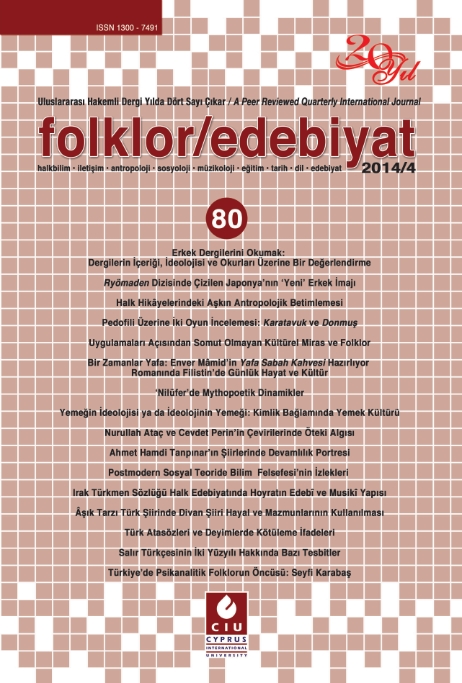Irak Türkmen Sözlü Halk Edebiyatinda Horyatin Edebî Ve Musiki Yapisi
The Literal and Musical Structure of Hoyrat in Irakian Turkmen Oral Folk Literature
Author(s): Sermet Mehdi TuzluSubject(s): Cultural history, Customs / Folklore, Music, Studies of Literature, Oral history
Published by: Uluslararası Kıbrıs Üniversitesi
Keywords: Irakian Turkmens; Oral Culture; Hoyrat;
Summary/Abstract: This study is consisted of two parts including the introduction. In the first part, under the heading of horiat’s literary structure, horiat’s definition and form features are explained by giving examples about six types, classified as the ones with puns, the ones with rhymes, the ones with redifs and rhymes, the ones with repetitions, the ones with wings and the ones composed of at least four lines. As for horiat’s themes, they are studied as fourteen types mentioning national conscience, sufistic belief, wisdom, bravery and exploit, luck and misfortune, sorrow, grief and gloom, love and attachment, advice, longing and seperation, wish and request, pray and curse, complaint about time, fate, love and beloved and good and bad friends. Examples from each theme are also provided. Under the second heading, horiat’s musical structures are examined. In this part, horiat’s musical definition, the history of horiat usuls and the information of twenty two usuls and their emergence are given including Atici, Beshiri, Darmangaha, Delliheseni, İdele, İskenderi, Karabas, Kesuk; Sharp Kesuk, Kesuk of Mehav, Kesuk Matari, Kizil, Kurde, Malalla, Mazan, Matari, Memeli, Muchila, Muhalif, Nobatchi, Sherife, Umergele and Yetimi. Horiat usuls are classified regarding their tune and dialect features: Usuls Bayati-flavoured; Karabash, Mazan, Sherife and Umergele; usuls Huseyniflavoured; İdele ve Yolchi; usuls Segah-flavoured; Atici, İskenderi; usuls Rast and Mahurflavoured; Beshiri and Yetimi; Matari usul with Chargah-flavoured. Usuls performed with different tune and dialects are detected as Darmangaha usul; Darmangaha Sabaflavoured (Kirkuk dialect), Darmangaha Huseyni-flavoured (Tuzhurmatu dialect), Usul Delliheseni; Delliheseni Hicaz-flavoured (Kirkuk dialect), Delliheseni Hicaz-flavoured (Tuzhurmatu dialect) and Delliheseni Bayati-flavoured (Erbil dialect), Kesuk usul Segah-flavoured; Sharp Kesuk, Kesuk of Mehav and Kesuk Matari, Usul Kizil; Kizil Rast-flavoured (Kirkuk dialect) and Kizil Charhag-flavoured (Tuzhurmatu dialect), Usul Kurde; Kurde Hicaz-flavoured (Emin Bagvan dialect), Kurde Tahir-flavoured (Yasin Bagvan dialect) and Telli Kurde Tahir-flavoured, Usul Muchila; Muchila Bayatiflavoured, Muchila Hicaz-flavoured and Usul Muchila Hicaz and Bayati-flavoured, Usul Nobatchi Hicaz and Bayati-flavoured, Usul Muhalif Huzzam-flavoured, Muhalif of Ottoman and Telli Muhalif. Horiat performer’s voice features are also handled.
Journal: Folklor/Edebiyat
- Issue Year: 20/2014
- Issue No: 80
- Page Range: 221-244
- Page Count: 24
- Language: Turkish

